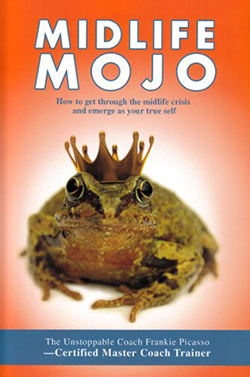
What is this thing we call Conscious Creation or The Law of Attraction?
Conscious Creation is not a new concept. It has been around for ages, so what is it?
Simply put, The Law of Attraction states that “We attract into our lives whatever we give our attention, energy, and focus, whether positive or negative.”
For instance, have you ever had a bad day get worse? Right, because you gave your time, energy and focus to all the bad. The same goes true for purple cars. Huh? Purple cars? That’s random. I know..but let’s say you are driving and you want to see purple cars. START looking for purple cars and ONLY purple cars and you will be amazed at how many show up. Now let’s go to the movies with Brent Marchant and see what shows up in our lives. J frankie
From Brent Marchants site: below
Many of the fundamental concepts of conscious creation may seem like practical, commonsense guidance for everyday living, and that’s true, to be sure. But when the principles are viewed collectively (with the concepts building upon one another and working synergistically) and applied with a heightened sense of awareness (a truly “conscious” outlook), they work together to provide a powerful means for approaching life. They generate a heightened sense of self-empowerment and self-awareness to help us shape our existence more to our liking. They enable us to address life’s opportunities, and to confront its challenges, more effectively and with a greater sense of fulfillment. Here’s a look at some of those concepts and films that exemplify them:
1. Becoming aware of how we formulate beliefs. Since beliefs are the starting point in conscious creation, it’s important to know how they form in the first place. This involves becoming aware of the roles that our intellect and intuition play in this process. They provide the input that our consciousness evaluates and then uses to shape the beliefs we hold based on such assessments. Awareness of this overall process, as well as the individual beliefs formed through it, is crucial for improving one’s proficiency in the practice of conscious creation. Movies that show this include the romantic comedy “Under the Tuscan Sun” (2003) and the ballet world drama “The Turning Point” (1977).
2. Going beyond surface perceptions. Because we tend to put more reliance on intellect than we do on intuition, we also tend to put a lot of stock into surface perceptions, those that we perceive with our five outer senses. But sometimes these impressions don’t tell the whole story. Looking beneath the surface provides a fuller picture, helping us to see that things aren’t always what they seem. It also helps us sharpen our intuitive sense, as noted above a key element in belief formation. These ideas are explored effectively in the family drama “Ordinary People” (1980), the French farce “King of Hearts” (1966), the riveting character study “A Beautiful Mind” (2001), the biting satire “Wag the Dog” (1997), the heartfelt father-and-son drama “Big Fish” (2003) and the gripping church drama “Doubt” (2008).
3. Understanding the relationship of science and spirit in our lives. In many ways, the harmony between these two forces is a metaphor for the relationship between intellect and intuition. Grasping the one aids comprehension of the other, and a number of pictures illustrate that, including the aforementioned DVD “The Secret” (2006), the eclectic conscious creation treatise “What the #$*! Do We (K)now!?” (2004), the engaging sci-fi drama “Contact” (1997) and the metaphysical talkfest “Mindwalk” (1991).
4. Drawing upon the power of choice and free will. If we each create our own reality, then it would stand to reason that we also must be the ones making the decisions about how that reality materializes. This is where the power of choice and free will comes into play. Surprisingly, however, it’s a power we often lose sight of. Maintaining an acute awareness of it is critical to formulating beliefs that allow us to create the existence we want, no matter how outlandish or unusual those choices may seem at times. Examples of pictures that illustrate this are the gut-wrenching drama “Sophie’s Choice” (1982), the edgy dark comedy “After Hours” (1985), the unconventional family drama “Housekeeping” (1987), the futurist yarn “Brave New World” (1998) and the heartwarming road trip tale “Away We Go” (2009).
5. Making changes when needed. When our beliefs don’t pan out as we’d like them to, it’s time to choose new ones. Being willing to evaluate our choices and to make changes to them (by rewriting the beliefs that underlie them) is essential to helping us achieve results more to our liking. Of course, we have to follow through on those changes in our choices to see them bear fruit; otherwise, we’re likely to remain locked in place, unsatisfied with our creations. Films that address such questions include the offbeat drama “The Truman Show” (1998), the gender-bending comedies “All of Me” (1984) and “Switch” (1991), the romantic fantasy “Peggy Sue Got Married” (1986), the quirky Woody Allen comedies “Zelig” (1983) and “The Purple Rose of Cairo” (1985) and the never-ending saga of “Groundhog Day” (1993).
6. Facing fears and living heroically. This is precisely what’s called for when making changes in our beliefs and in our lives. Without the courage to do this, we really will stay stuck in place. Many movies delve into this subject beautifully, but some of my favorites are the soul-searching sci-fi drama “Signs” (2002), the courageous leap of faith character study “An Unmarried Woman” (1978), the Alfred Hitchcock classic “Vertigo” (1958), the otherworldly romantic comedy “Defending Your Life” (1991), and a trio of contemporary heroic tales (all from 2005), “The Constant Gardener,” “Syriana” and “Good Night, and Good Luck.”
7. Assessing the evolution of our beliefs. Looking at how our beliefs change over time gives us a sense of how far we’ve come with regard to achieving a particular goal. By taking stock of our beliefs in this way, we can see where further changes may be needed as well. Films in the road trip genre are especially effective at illustrating this principle, and some great examples include the cinematic classic “The Wizard of Oz” (1939), the screwball comedy “Flirting with Disaster” (1996), the action adventure “Indiana Jones and the Last Crusade” (1989) and the Frank Capra fantasy “Lost Horizon” (1937).
8. Appreciating the connectedness of all things. If we each truly create our own reality, then we indeed create the totality of that reality as well, including all its component parts. When we consider how intricately all of the various elements of our existence are interwoven with one another, it becomes clear just how careful we must be when making choices, formulating beliefs and effecting changes to them, for the implications can be far-reaching and unexpected. A number of movies explore this idea well, including the ironically titled “Six Degrees of Separation” (1993), the dysfunctional character study “American Beauty” (1999), the engaging gay drama “Hard Pill” (2005), the angst-ridden L.A. sagas “Grand Canyon” (1991) and “Crash” (2005), the heartwarming tale “Pay It Forward” (2000) and the sci-fi blockbuster “Avatar” (2009).
9. Exceeding our personal limitations. A chief aim of conscious creation is to create the reality we desire, something frequently achieved through spurts in our personal growth. Such advances can be realized by thinking the unthinkable, envisioning possibilities never before dreamed of, and imbuing ourselves with skills we never knew we had or thought possible. Also, it can involve allowing ourselves to wander the uncharted territories of alternate states of consciousness, such as those experienced in dreams, meditations and other unconventional states of mind. Imagine what’s possible with outlooks like that! Sci-fi and fantasy films are especially good at helping us see such possibilities, because they inherently push limits as part of their very story lines. Some great examples are “What Dreams May Come” (1998), “Phenomenon” (1996), “Resurrection” (theatrical version, 1980; made-for-TV version, 1999),
“K-PAX” (2001), “The Lathe of Heaven” (1980), “Brainstorm” (1983), “Eternal Sunshine of the Spotless Mind” (2004) and “Pleasantville” (1998).
10. Experiencing the joy and power of creation. As self-evident as this may seem, becoming more conscious of this state of being is tremendously uplifting. It allows us to experience being our own best selves, living up to our potential for the betterment of our own lives and those of others around us. It begs the question, “Who wouldn’t want to live a life like that?” We can see such sublime joy and tremendous power made manifest through such pictures as the gentle comedy “Being There” (1979), the Christmas classic “It’s a Wonderful Life” (1946), the inspiring, high-flying historical adventure
“The Right Stuff” (1983), the dreamy fantasy world of “Wings of Desire” (1987) and the heartwarming sports drama “The Blind Side” (2009).
Consider what’s possible when all of these steps are put together, not only for achieving the existence we want to lead for ourselves but also for the greater world in which we dwell. The satisfaction and rewards of such a life are truly worth experiencing. And to think it can all stem from the inspiration that movies provide us in learning how to employ conscious creation principles.” Brent
FrankieSense & More is a socially conscious show. Every guest, theme and show, is in fact, my way of helping bring more positivity into your lives, raising our collective vibration so we can lower fear and counteract the negativity which is so prevalent in the world today. I do this with deliberate intention of making the world a better place.
Return to the FrankieSense and More Podcast Page














